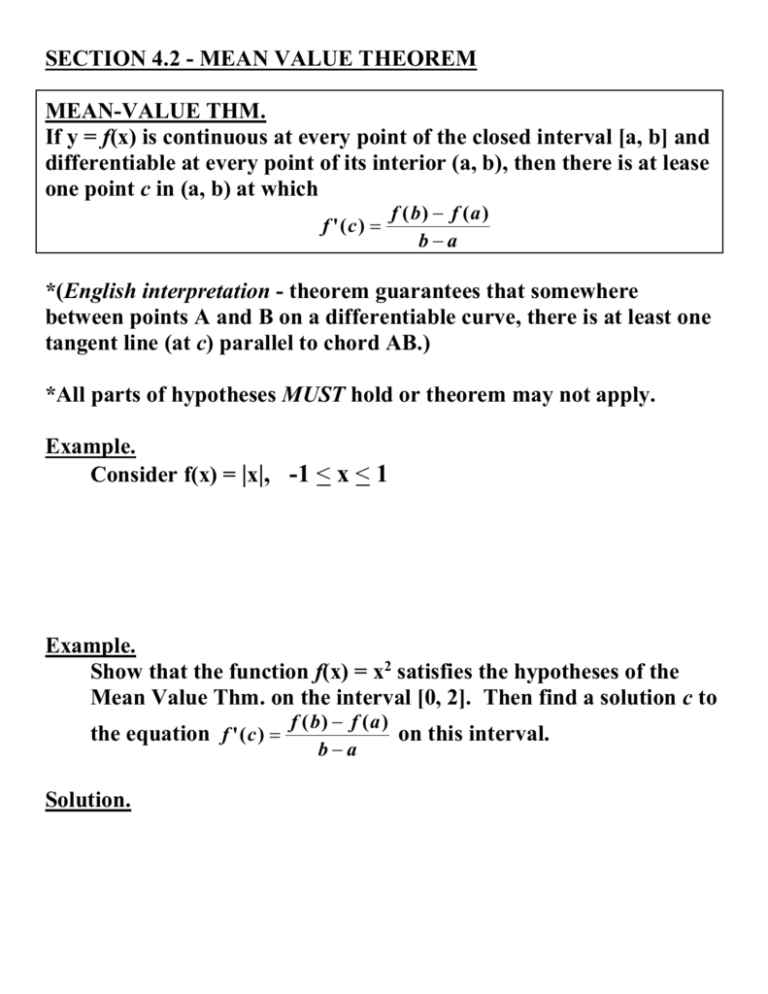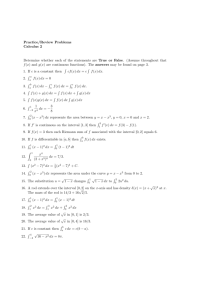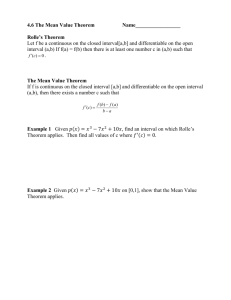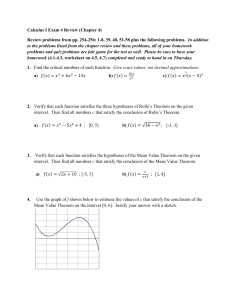Sect 4_2 - Collingswood High School
advertisement

SECTION 4.2 - MEAN VALUE THEOREM MEAN-VALUE THM. If y = f(x) is continuous at every point of the closed interval [a, b] and differentiable at every point of its interior (a, b), then there is at lease one point c in (a, b) at which f '( c ) f ( b) f (a ) ba *(English interpretation - theorem guarantees that somewhere between points A and B on a differentiable curve, there is at least one tangent line (at c) parallel to chord AB.) *All parts of hypotheses MUST hold or theorem may not apply. Example. Consider f(x) = |x|, -1 < x < 1 Example. Show that the function f(x) = x2 satisfies the hypotheses of the Mean Value Thm. on the interval [0, 2]. Then find a solution c to the equation f '( c ) Solution. f ( b) f (a ) on this interval. ba Example. Let f(x) = 1 x 2 , A ( 1, f ( 1), and B (1, f (1)). Find a tangent to f in the interval (-1, 1) that is parallel to the secant AB. Solution. Interpreting the Mean Value Thm. If a car accelerating from zero takes 8 sec to go 352 ft., its avg. velocity for the 8-sec interval is 352/8 = 44 ft/sec, or 30 mph. At some point during the acceleration, the theorem says, the speedometer must read exactly 30 mph. INCREASING AND DECREASING FUNCTIONS Let f be a function defined on an interval I and let x1 and x2 be any two points in I. 1. f increases on I if x1 < x2 and f(x1) < f(x2). 2. f decreases on I if x1 > x2 and f(x1) > f(x2). Let f be continuous on [a, b] and differentiable on (a,b). 1. If f ' > 0 at each point of (a,b), then f increases on [a,b]. 2. If f ' < 0 at each point of (a,b), then f decreases on [a,b]. Example. Where is the function y = x2 increasing and decreasing? Solution. Example. Where is the function f(x) = x3 - 4x increasing and where is it decreasing? Solution. CONSTANT FUNCTIONS Corollary If f '(x)=0 at each point of an interval I, then there is a constant C for which f(x)=C for all x in I. Corollary If f '(x) = g '(x) at each point of an interval I, then there is a constant C such that f(x) = g(x) + C for all x in I. Example. Find the function f(x) whose derivative is sin x and whose graph passes through the point (0, 2). Solution. Definition: Antiderivative A function F(x) is an antiderivative of a function f(x) if F '(x) = f(x) for all x in the domain of f. The process of finding an antiderivative is antidifferentiation. Example. Find the velocity and position functions of a freely falling body for each of the following sets of conditions: (a) The acceleration is 9.8 m/sec2 and the body falls from rest. (b) The acceleration is 9.8 m/sec2 and the body is propelled downward with an initial velocity of 1 m/sec. Solution:










